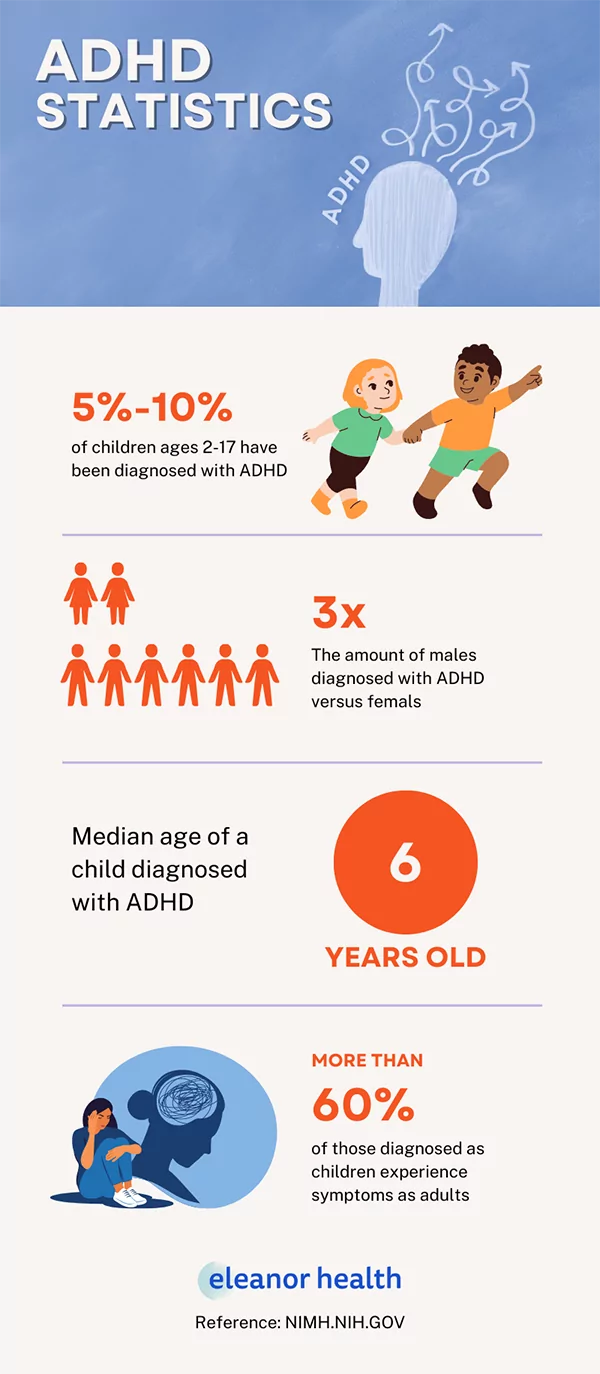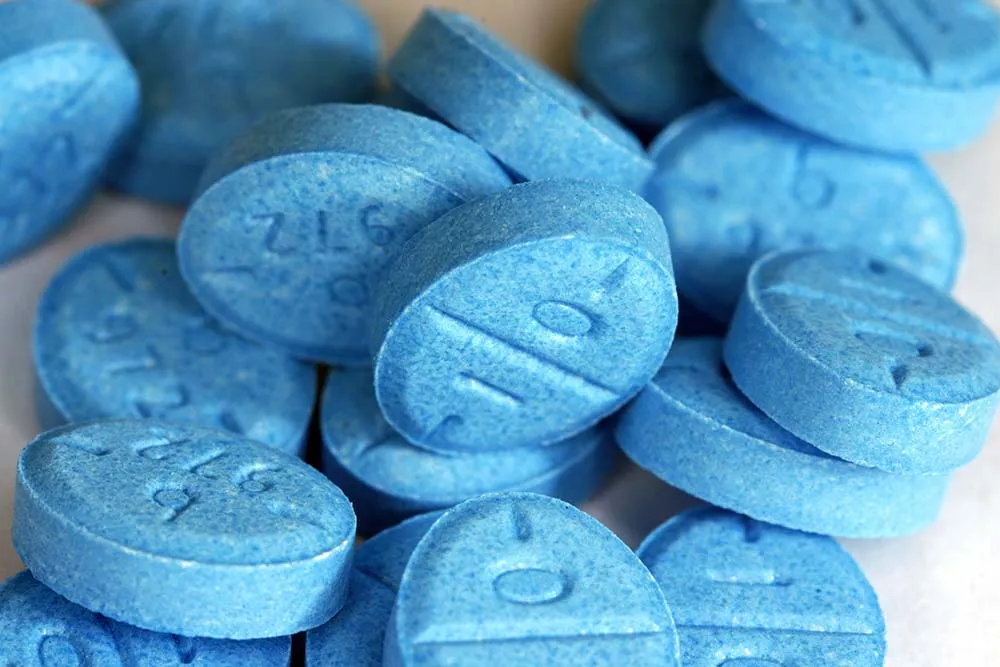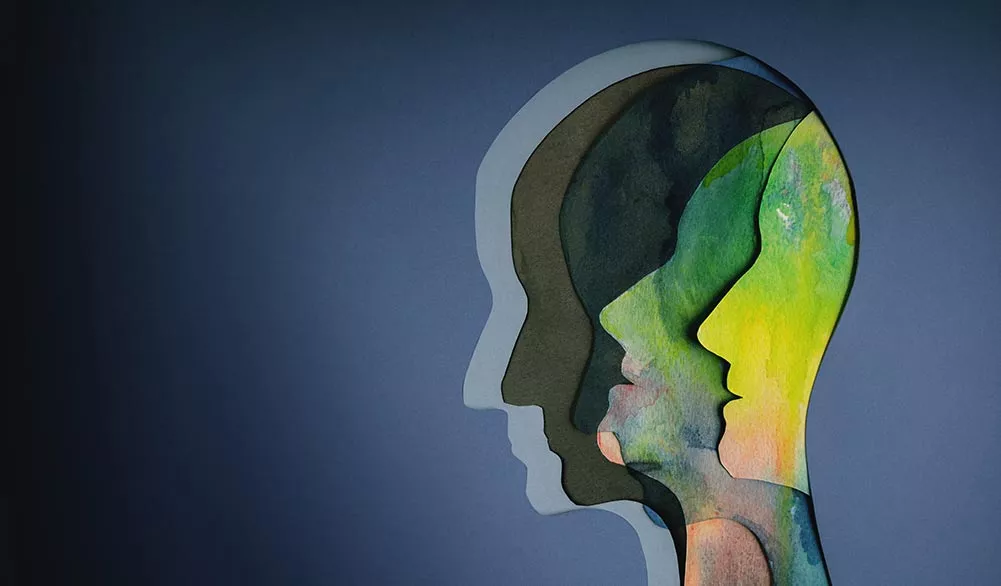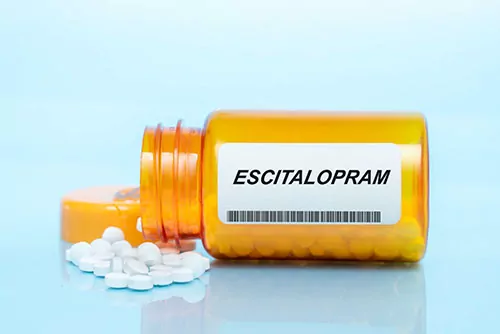If you’ve heard of attention-deficit/hyperactivity disorder (ADHD), chances are you have some preconceived notions about what it looks like. Maybe you picture a hyperactive little boy who can’t sit still in class, but ADHD is far more complex and often misunderstood.
In reality, ADHD is a neurodevelopmental disorder that affects a person’s ability to regulate attention, emotions, and/or impulsive behaviors. It’s important to note that people with ADHD don’t actually lack attention, but rather struggle to regulate it.
Understanding ADHD is key to ensuring that people receive the appropriate diagnosis, care, and treatment they need to thrive.
Unlike many other mental health conditions, ADHD impacts an individual’s executive functioning, which are typical mental skills relating to working memory, flexible thinking, and self-control. ADHD symptoms revolve around an individual’s executive functioning and fall within 2 distinctive categories: inattention and hyperactivity/impulsivity.
Inattention is one of the primary symptoms of ADHD. People with this condition may experience the following symptoms related to inattention:
It’s essential to note that while everyone experiences some of these symptoms at different points in their life, people with ADHD experience many of these symptoms consistently across all areas of life.
Hyperactivity or impulsivity is the other primary symptom of ADHD. People with this condition may experience the following symptoms related to hyperactivity or impulsivity:
Just like with inattention symptoms, everyone can experience some of these symptoms at different points in their life. However, people with ADHD experience them consistently across all areas of life.
As an example, everyone likely experiences difficulty focusing in long, detailed business meetings. However, those without ADHD can push themselves to listen and remember what’s discussed, with a little bit of effort. People with the disorder, though, have different experiences on a neurological level in which their brains do not communicate the same way internally. They cannot push themselves into focusing and retaining information, which can have significant impacts on their home, work, and social lives.
Accurately recognizing and identifying attention-deficit/hyperactivity disorder takes a well-trained professional. While your primary care physician may be able to make recommendations or refer you to a mental health professional, they are often not trained or qualified to make a diagnosis.
To be diagnosed with ADHD, a person must have experienced several qualifying symptoms frequently and in multiple areas of life (work, relationships, school, etc.) over the last six months. They must also have shown many symptoms in childhood if they’re now an adult. Professionals may also gather information about family history with the disorder since there seems to be a strong genetic component in its development.
If you’ve experienced many ADHD symptoms that have significantly impacted your life, talk to your doctor about your concerns and options. They can help you understand the disorder and refer you to a specialist who can further help.

ADHD is the most common mental disorder in childhood and affects 3 times as many males versus females. It is estimated that between 5-10% of children ages 2-17 have had a diagnosis of ADHD. The median age of diagnosis is 6 years old. Recent studies indicate that more than 60% of those who are diagnosed as children continue experiencing symptoms as adults. Rates of diagnosis are also increasing in the U.S.
Many misconceptions surround the causes and risk factors associated with developing ADHD. While research has yet to find a clear cause of the disorder, the link between ADHD and commonly-blamed sources like sugar, TV, and video games is not supported by research. However, there are certain factors that evidence shows may affect a person’s likelihood of having the disorder, including:
Because ADHD is a neurological and developmental disorder that impacts how someone’s brain works and it begins displaying in childhood, there aren’t as many risk factors associated with its development. However, the presence of attention-deficit/hyperactivity disorder can be a risk factor for other problems, including:
Between 60 and 80% of people with attention-deficit/hyperactivity disorder have one or more co-occurring disorders or conditions. While there’s not a clear reason why this is, many find relief for both issues when they’re able to effectively treat and manage their ADHD.
Despite previous thought that it was a disorder to be “outgrown” after childhood, recent research indicates that ADHD is often chronic. While there’s currently no cure for attention-deficit/hyperactivity disorder, there are many ways to manage symptoms. For example, doing higher-intensity exercise for at least 30 minutes 3-5 days a week can have a huge impact on hyperactivity symptoms, while building a structured routine in which chores, meals, work, sleep, and other activities are done at the same time every day can help someone navigate some of the inattentive symptoms.
Many helpful skills and strategies, like the ones mentioned above, are often taught and discussed in therapy. Therapy sessions with a trained ADHD specialist can help someone understand exactly how the disorder impacts their thoughts and behaviors, sort through the emotion often tied up in these issues, and come up with practical solutions for managing symptoms and addressing the disorder head-on.
While therapy can be beneficial for some, medication is often necessary to help manage symptoms effectively.
ADHD medication typically falls into two categories: stimulants and non-stimulants. Stimulants, like Adderall, are effective for many individuals with ADHD, but they may come with side effects like increased anxiety or decreased appetite. Non-stimulant options are available, but they are not as well-researched and can be challenging to obtain due to insurance coverage limitations.
Stimulant medication works by targeting the central nervous system and slowing dopamine reabsorption in the brain. This action helps to improve communication between brain cells and reduce ADHD symptoms. While stimulants can be incredibly effective, it’s essential to work with a doctor to manage potential side effects like anxiety or heart palpitations.
Non-stimulant medication is another option for managing ADHD symptoms. These medications include guanfacine, an FDA-approved medication for high blood pressure, which has been shown to help alleviate ADHD symptoms in some individuals. Another option is bupropion, an antidepressant that can be effective in treating ADHD symptoms, but it may not be as potent as stimulant medication.
As more research is done to understand the complexity of ADHD and how it works, treatment drastically improves. Talk to your doctor about what’s right for you and your concerns. Because ADHD symptoms and severity differ from person to person, treatment needs to be custom fit for your exact needs.
It’s important to note that there is no one-size-fits-all approach to treating ADHD. Different treatments work better for different people, and it may take some trial and error to find the best treatment plan. If you or a loved one exhibits symptoms of ADHD, it’s important to seek out medical evaluation and support.
 What is Adderall?
What is Adderall?
 Types of Personality Disorders
Types of Personality Disorders
 What is Lexapro? (Escitalopram)
What is Lexapro? (Escitalopram)